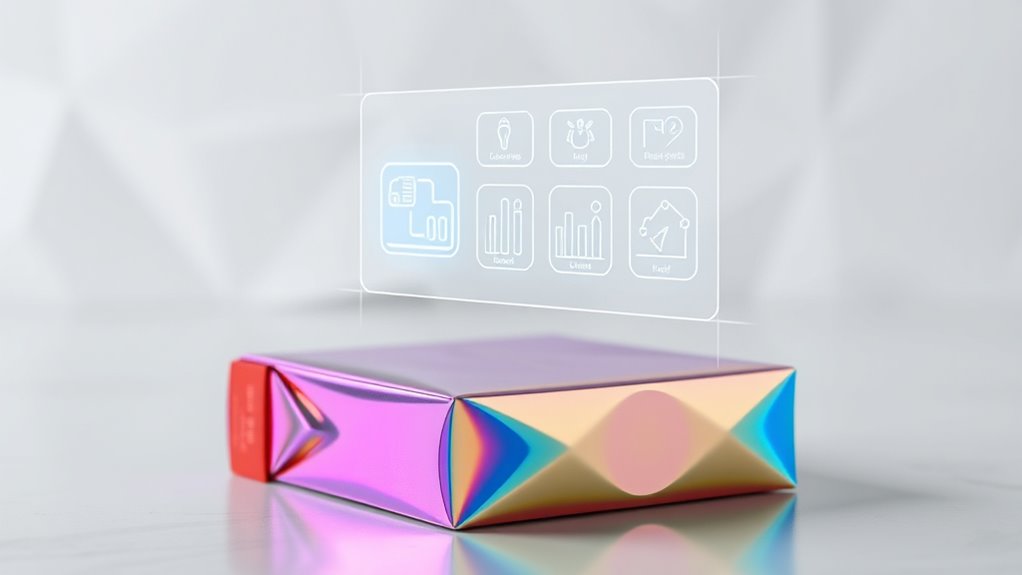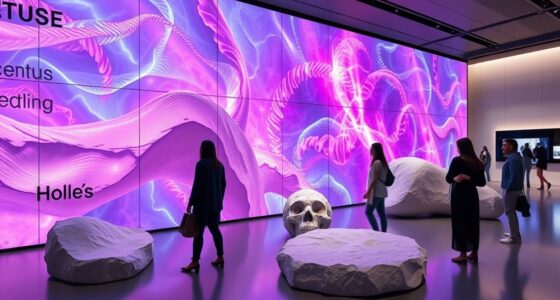Augmented reality in product packaging turns ordinary containers into interactive portals for engaging brand stories. With AR, you can see virtual environments or animated characters that bring products to life, creating memorable experiences. It also allows for virtual try-ons, personalized demos, and more immersive shopping. Packaging becomes a digital platform that strengthens your brand connection. Keep exploring to discover how this innovative technology is shaping the future of packaging design and consumer engagement.
Key Takeaways
- AR transforms traditional packaging into interactive portals for immersive brand storytelling and virtual experiences.
- It enables virtual try-ons and customization directly on packaging, enhancing consumer engagement and purchase confidence.
- AR-integrated packaging serves as a digital platform for demonstrations, personalized content, and brand loyalty building.
- Incorporating AR in packaging creates memorable, entertaining experiences that strengthen consumer-brand relationships.
- Future trends include more immersive, sustainable AR packaging that aligns with eco-conscious consumer preferences.

Have you ever wondered how augmented reality (AR) is transforming product packaging design? AR offers a dynamic way to engage consumers, turning ordinary packages into interactive experiences. One of the most exciting aspects of this innovation is how it enables brands to craft immersive storytelling around their products. Instead of static labels, your packaging can now serve as a portal into a brand’s story, history, or values. When you scan a package with your smartphone, you might see a virtual environment that narrates the journey of the product from sourcing to shelf or even animated characters that bring the brand to life. This form of interactive storytelling captures your attention and creates a memorable connection, making the product stand out in a crowded marketplace.
Another key feature AR introduces is virtual try-ons, which are particularly impactful in categories like cosmetics, fashion, and accessories. Imagine holding a bottle of perfume or a piece of jewelry and being able to see how it looks on you without ever trying it physically. This technology reduces the hesitation often associated with purchasing, especially online, and enhances your confidence in the decision. Virtual try-ons make the experience more personalized, allowing you to experiment with different styles, colors, or looks in real-time. As you explore options on your device, AR overlays realistic images directly onto your view of yourself, giving you a sense of how the product will appear in real life. This interactive element encourages you to engage more deeply with the product and ultimately increases the likelihood of purchase.
AR’s ability to blend digital content with physical packaging is reshaping how brands communicate with you. It transforms packaging from a simple container into an interactive platform where storytelling and virtual try-ons create a richer, more engaging shopping experience. You’re no longer just looking at a label; you’re immersing yourself in a world of brand narratives and personalized demonstrations. This shift not only enhances your experience but also helps brands foster loyalty by offering innovative, memorable interactions. As AR technology continues to evolve, you can expect packaging to become even more intelligent and entertaining — making your interactions with products more engaging, more informative, and more fun. The future of product packaging is clearly heading toward a seamless integration of digital storytelling and virtual try-ons, ensuring that your relationship with brands becomes increasingly immersive and personalized. Additionally, integrating sustainable practices into AR packaging can further strengthen brand values and appeal to environmentally conscious consumers.
Frequently Asked Questions
How Does AR Impact Consumer Purchasing Decisions?
AR impacts your purchasing decisions by making products more engaging through virtual try-ons and interactive labels. When you see how a product looks on you or explore detailed info via AR, you’re more likely to trust and choose it. This immersive experience builds confidence, reduces hesitation, and enhances satisfaction. Fundamentally, AR transforms your shopping into a fun, interactive process, encouraging you to make quicker, more informed buying decisions.
What ARe the Cost Implications of Implementing AR in Packaging?
Implementing AR in packaging involves significant costs, including a thorough cost analysis of development, hardware, and software. You may face implementation challenges like integrating AR features smoothly with existing systems and ensuring compatibility across devices. While upfront expenses can be high, consider long-term benefits like increased engagement and brand loyalty. Careful planning and budgeting help you manage these costs effectively, maximizing your return on investment and overcoming potential hurdles.
How Do Brands Measure AR Campaign Success?
You measure AR campaign success by tracking digital engagement metrics like app interactions, time spent, and shares, which show how well your audience connects with your brand. Additionally, monitor brand differentiation by analyzing how AR features set your packaging apart from competitors. Customer feedback and sales uplift also indicate effectiveness. Combining these data points helps you understand if your AR efforts boost engagement and strengthen your brand’s unique position in the market.
ARe There Specific Industries Benefiting Most From AR Packaging?
You’ll find that industries like food and beverage, beauty, and retail benefit most from AR packaging. Interactive labels create engaging experiences, making products stand out on shelves and boosting brand engagement. These sectors use AR to tell brand stories, provide product details, and foster customer loyalty. By integrating AR, you enhance consumer interaction, increase product appeal, and generate memorable shopping experiences that drive sales and strengthen your brand presence.
What ARe the Challenges in Integrating AR With Existing Packaging?
Integrating AR into packaging can feel like fitting a square peg into a round hole. You might face technical constraints like limited hardware capabilities and compatibility issues, making seamless integration tricky. Additionally, ensuring a smooth user experience is essential; if users struggle to access or navigate AR features, engagement drops. Overcoming these hurdles requires careful planning, robust technology, and user-focused design to make AR a natural part of your packaging.
Conclusion
As you embrace augmented reality in packaging design, you reveal a world where products become living stories, inviting customers to dive deeper into your brand’s universe. It’s like turning a simple package into a vibrant portal, sparking curiosity and forging unforgettable connections. With every scan, you breathe life into your products, transforming static items into dynamic experiences. This isn’t just innovation; it’s your chance to make your brand’s heartbeat visible, resonating long after the package is opened.








